Companion planting can be a great way to create a productive and healthy garden. By choosing plants that have beneficial relationships with one another, gardeners can increase soil fertility, reduce pest populations, and increase pollination. Additionally, companion planting can save space and reduce weeding, making it a great choice for gardeners of all levels. Here are the best (and the worst) garlic companion plants.

What Is a Companion Plant?
Companion plants are plants that are planted together in the same area for a beneficial relationship. These plants can be beneficial to each other in a variety of ways, such as providing shade, repelling pests, increasing pollination, and improving soil quality. Companion planting can be used to create a more diverse, healthy, and productive garden.
The benefits of companion planting in the garden include improved soil fertility, increased pest control, and improved pollination. Soil fertility can be improved by companion planting. Different plants require different levels of nutrients, and by planting together, the nutrient levels can be balanced. Additionally, companion planting can help to reduce pest populations because certain plants are known to repel certain pests. Finally, companion planting can help to increase pollination. Some plants attract bees and other beneficial insects that help to spread pollen.
Companion planting can also help to save space in the garden. By planting compatible plants together, they can take up less space while still providing a variety of benefits. Additionally, companion planting can help to reduce weeding since certain plants are known to out-compete weeds.
13 Best Garlic Companion Plants
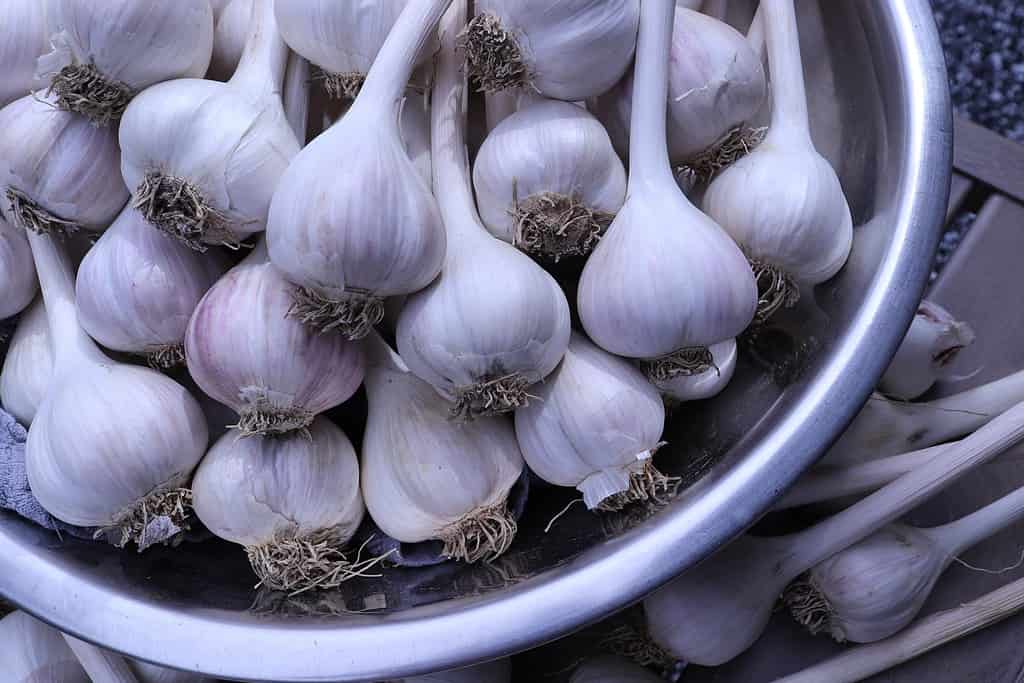
©KC Melete/Shutterstock.com
Garlic is a versatile and beneficial companion plant for various reasons. First, its strong aroma helps repel pests such as aphids, beetles, and slugs from neighboring plants. Additionally, garlic’s natural compounds act as a deterrent against fungal diseases that commonly affect crops. Lastly, it attracts pollinators such as bees, enhancing overall garden biodiversity and yield.
1. Beets
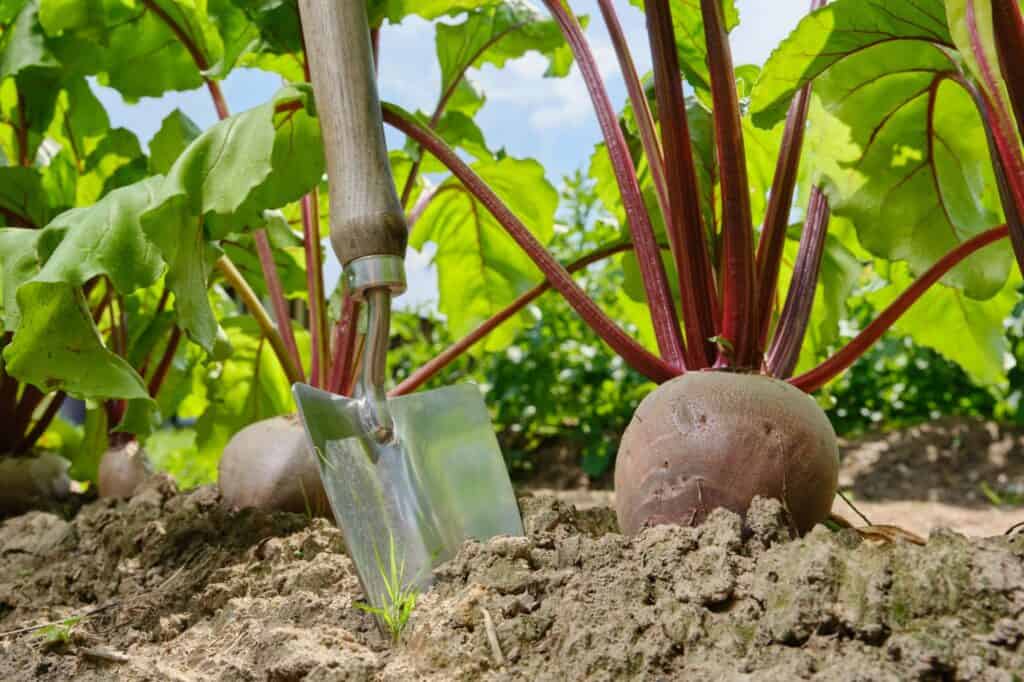
The vigorous root systems of garlic and beets work in unison to break up compacted earth.
©Vlad Antonov/Shutterstock.com
Growing garlic and beets together is not only a brilliant gardening strategy but also a mutually beneficial pairing. It that can enhance the health and productivity of both crops. These two plants, with their distinct nutrient requirements, harmoniously coexist without robbing each other of vital resources. While garlic draws its nutrients from deeper levels in the soil, beets derive theirs from shallower depths, ensuring minimal competition for sustenance.
Moreover, this dynamic duo contributes to improving the overall soil structure as they grow side by side. Their vigorous root systems work in unison to break up compacted earth. This promotes better water drainage and oxygen circulation below the surface.
In addition to these remarkable benefits, garlic acts as a natural defender for neighboring beet plants. It protects against menacing fungal diseases such as fusarium wilt and downy mildew. Its potent antimicrobial properties help suppress these pathogens, safeguarding the delicate foliage of nearby beets from potential harm.
2. Cucumbers
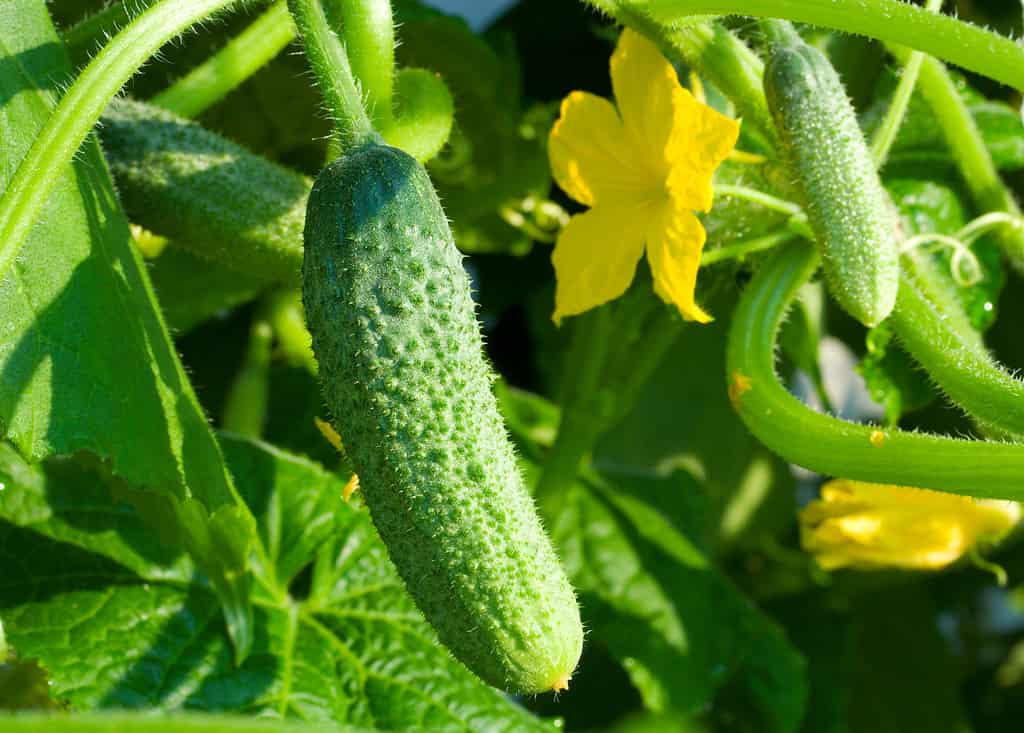
Planting garlic near cucumber plants increases the presence of calcium, potassium, and nitrogen in the soil.
©Andrey Shtanko/Shutterstock.com
Cucumbers are an excellent garlic companion plant because garlic helps to improve the nutrient content in the soil. This means that cucumber plants will grow bigger and stronger. Planting garlic near cucumber plants increases the presence of calcium, potassium, nitrogen, phosphorus, and manganese in the soil. This results in larger yields of cucumbers. Therefore, more garlic planted in proximity to cucumber plants leads to better benefits for cucumbers!
3. Fruit Trees
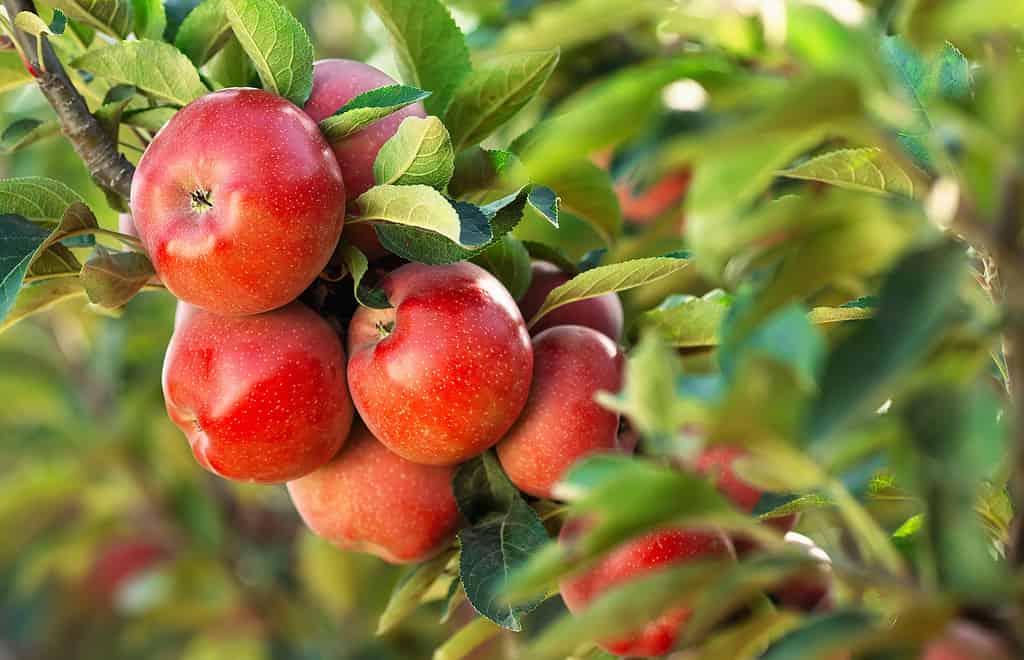
Growing garlic near your apple trees can help deter apple scabs and aphids.
©David Tadevosian/Shutterstock.com
One of the most beneficial aspects of garlic as a companion plant for fruit trees is its natural ability to repel various pests that can cause harm. Garlic acts as a deterrent against common threats such as caterpillars, Japanese beetles, aphids, and borers. Garlic creates a protective shield around the fruit trees. By planting garlic in close proximity to these trees, gardeners can effectively minimize pest infestations and reduce potential damage.
Furthermore, another advantage of incorporating garlic into the orchard ecosystem is its capability to attract pollinating insects. These buzzing visitors play an essential role in the fertilization process necessary for fruit production. The pungent aroma emitted by garlic serves as a powerful magnet for bees, butterflies, and other vital pollinators. As they visit the fragrant blossoms of both garlic and fruit trees alike, these industrious creatures facilitate cross-pollination among flowers and contribute to bountiful harvests.
4. Eggplants
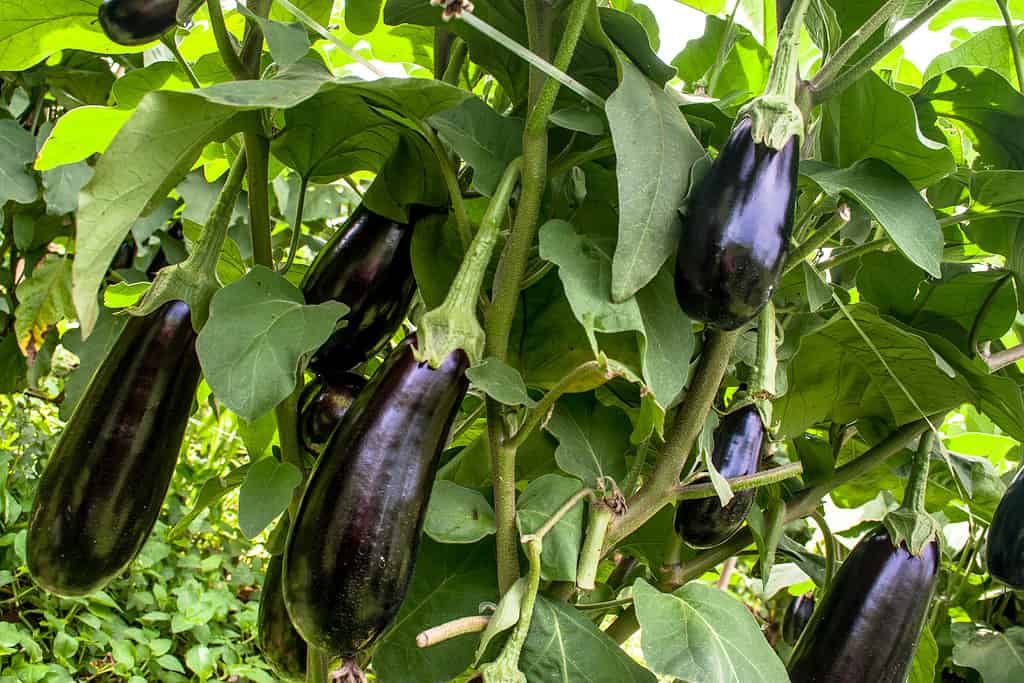
Garlic provides protection for eggplants’ delicate leaves and stems as they develop.
©Alf Ribeiro/Shutterstock.com
Eggplants are a member of the nightshade family. They have long been recognized as an ideal companion plant for garlic due to their mutually beneficial relationship. When grown together, these two plants offer a multitude of advantages that enhance both their growth and yield. The presence of garlic acts as a natural deterrent against pests and diseases commonly affecting eggplants. It also provides protection for delicate leaves and stems as they develop. Scientific studies have even revealed that planting garlic alongside eggplants can significantly increase the overall productivity of your eggplant crop. This results in a bountiful harvest.
As your eggplant plants begin to thrive and expand in size, they may inadvertently overshadow the garlic bulbs if left unattended. Therefore, timely harvesting becomes essential to prevent excessive shading from hindering the growth potential of your precious garlic crop.
5. Tomatoes

Many gardeners say that growing garlic in close proximity enhances the taste of tomatoes.
©iStock.com/Grahamphoto23
Garlic is a versatile and powerful herb known for its pungent aroma and distinct flavor. It proves to be an invaluable companion for tomatoes in your garden. The symbiotic relationship between these two plants goes beyond just sharing the same space. It offers a multitude of benefits that enhance both their growth and overall health.
One of the key advantages of planting garlic alongside tomatoes is its ability to repel common pests that often plague tomato crops. Infamous culprits such as spider mites and aphids are deterred by the natural compounds emitted by garlic. This creates a protective shield around your precious tomato plants. This natural defense mechanism helps safeguard against potential infestations, allowing your tomatoes to thrive without succumbing to harmful insect damage.
Not only does garlic act as a formidable guardian against unwanted pests, but it also contributes significantly to improving the flavor profile of tomatoes. Many avid gardeners attest that growing garlic in close proximity enhances the taste nuances of this beloved fruit (yes, technically speaking, it’s a fruit!). The aromatic oils released by garlic permeate through the air and subtly intertwine with the flavors of ripening tomatoes. As a result, you can expect more robust and flavorful harvests.
Furthermore, another practical advantage lies in conveniently harvesting both plants simultaneously due to their compatible growth patterns. When planning delectable meals featuring juicy ripe tomatoes accompanied by richly flavored garlic cloves, having them in the same place is helpful.
6. Peppers

Garlic, tomatoes, and peppers are all good neighbors in the garden.
©Vitalii M/Shutterstock.com
Peppers are great companion plants for garlic. They really thrive in the sun and heat, but they can be vulnerable to certain fungal diseases. Planting garlic nearby can help keep these fungi at bay. Plus, both garlic and peppers are key ingredients in salsa! So planting them together means you can pick them both and make a delicious salsa right away.
7. Spinach

Weeds can crowd out young garlic plants. Planting spinach as a groundcover can help with this issue.
©iStock.com/JackF
Grow spinach, lettuce, and arugula around your garlic plants to act as a groundcover and keep weeds from consuming them. Look for a variety of spinach that spreads 6 to 12 inches and is no taller than 9 inches. An example is Double Take Hybrid, which is perfect for this purpose.
8. Brassicas

Cabbage loopers, notorious for their destructive feeding habits, are deterred by garlic’s aroma.
©iStock.com/Lusyaya
In the world of gardening, garlic is widely recognized as an excellent companion plant for members of the Brassica family. These include popular vegetables such as kohlrabi, kale, cabbage, and cauliflower. The benefits derived from planting garlic alongside these crops go beyond its culinary appeal.
One notable advantage of growing garlic alongside Brassicas is its natural ability to repel a range of pests. There are many bugs that commonly afflict these vulnerable crops. Cabbage loopers, notorious for their voracious appetite and destructive feeding habits, are deterred by the pungent aroma emitted by garlic plants. Similarly, cabbage maggots and cabbage worms find themselves discouraged from laying eggs or feasting on young seedlings when in close proximity to this aromatic herb.
Japanese beetles also pose a significant threat to Brassica plants. However, they, too, are effectively kept at bay with the presence of garlic nearby. With its potent scent acting as a deterrent against these leaf-chomping pests, garlic acts as a powerful ally in safeguarding your precious vegetable patch.
Beyond its pest-repelling qualities, growing garlic alongside members of the Brassica family can have additional benefits. Some gardeners believe that it improves flavor profiles, while others argue that it enhances overall disease resistance among neighboring plants. Whether through allelopathic interactions or simply providing shade and shelter to adjacent crops during hot summer days. There seems to be more at play than meets the eye when pairing this dynamic duo in your garden beds.
9. Potatoes
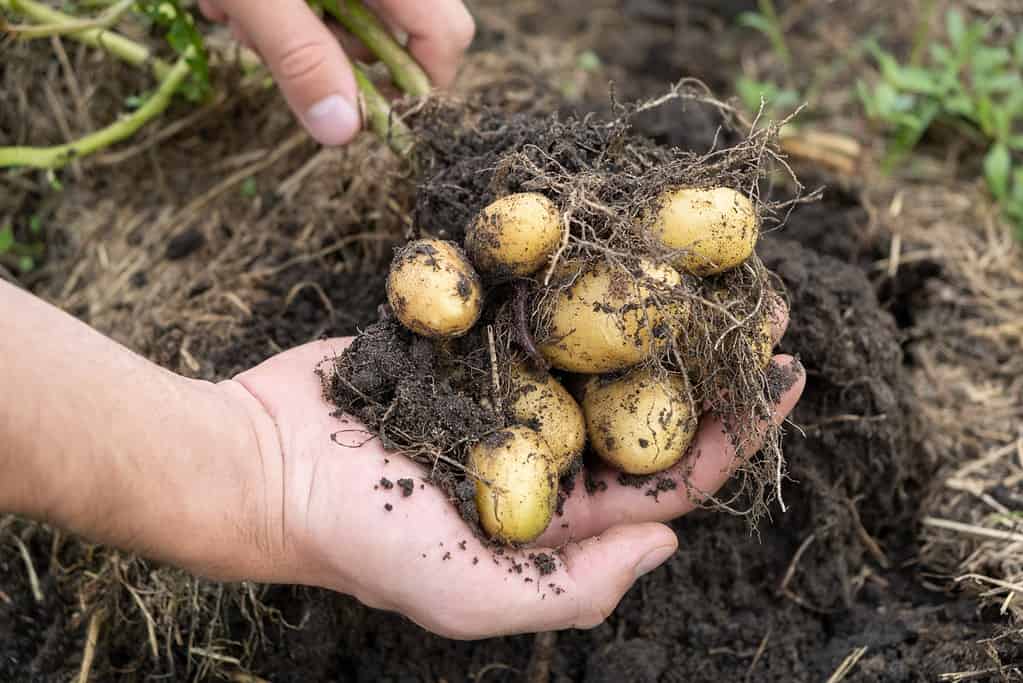
You can prevent many potato diseases by planting garlic nearby.
©ArieStudio/Shutterstock.com
Garlic, known for its pungent aroma and culinary uses, possesses a remarkable ability to combat fungal diseases in potatoes. One of the most notorious adversaries of potato crops is late blight. This is a devastating fungal infection that can decimate entire harvests. However, through its potent fungicidal properties, garlic emerges as an invaluable ally in protecting these tubers from this perilous threat.
Fascinatingly, scientific studies have revealed that cultivating potatoes alongside companion plantings of garlic yields impressive results. Even better results than relying solely on chemical fungicides. This synergistic relationship between these two crops taps into nature’s intricate web of interconnectedness.
10. Tarragon
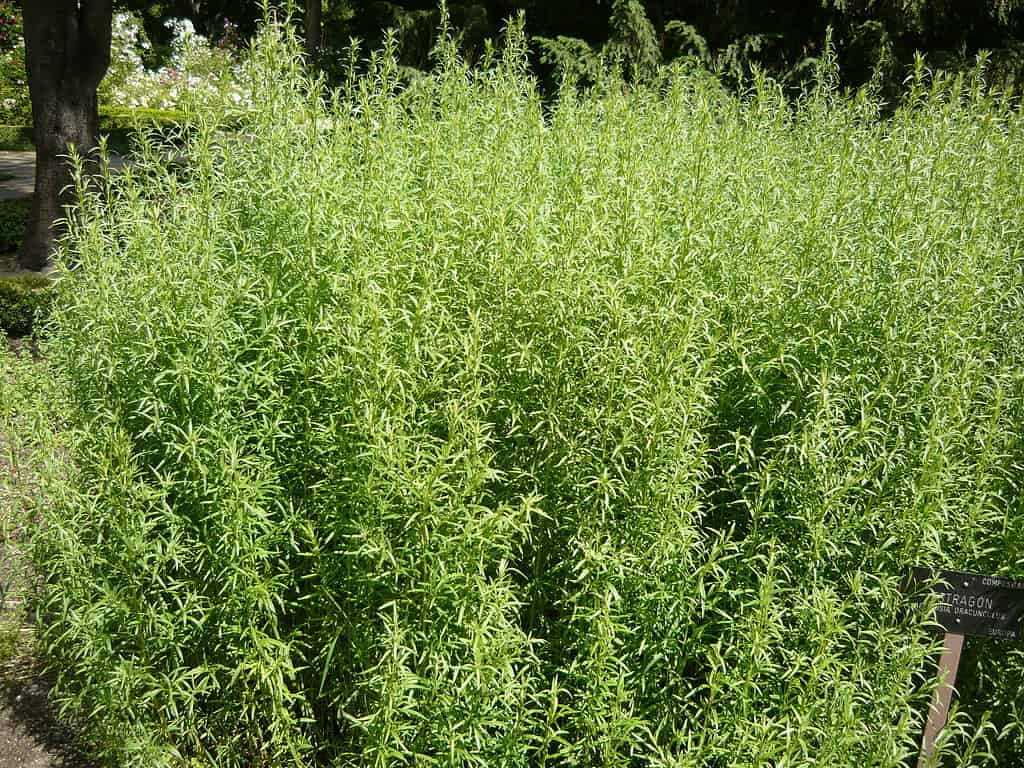
If you want your garlic plants to be robust, consider planting tarragon nearby.
©Cillas / CC BY-SA 4.0, via Wikimedia Commons – Original / License
Tarragon, a sharp and savory herb, is renowned for its ability to enhance the growth of garlic plants. As a companion plant, tarragon lends its unique qualities to create an optimal environment for garlic cultivation. With its distinct flavor profile and beneficial characteristics, this herb has become one of the top choices among gardeners seeking to maximize their garlic harvest.
The presence of tarragon in close proximity to garlic contributes to the overall health and vigor of the plants. It also aids in optimizing their growth rate. Tarragon’s natural compounds act as stimulants, promoting robust root development and enabling efficient nutrient uptake by garlic bulbs. This symbiotic relationship between tarragon and garlic results in accelerated growth. This ensures that each clove receives ample nourishment throughout its lifecycle.
11. Dill
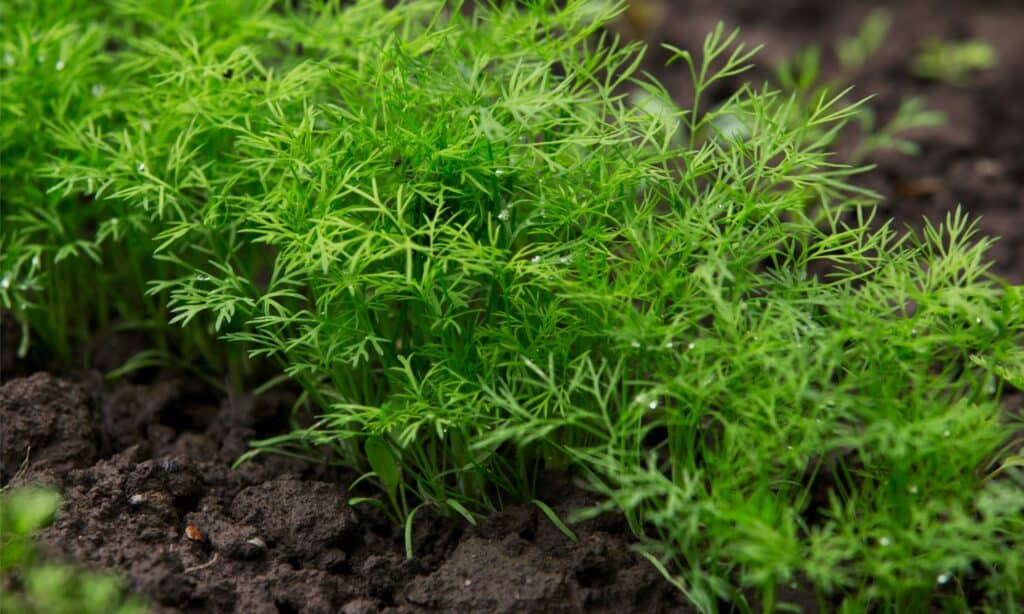
Dill is key to making dill pickles! It is also an excellent plant to grow near garlic.
©iStock.com/DevidDO
Garlic, with its natural repellent properties against spider mites, proves to be an excellent companion for dill in the garden. Dill, a versatile herb known for its delicate flavor and unique aroma, also forms a beneficial alliance with garlic. The pungent scent of garlic bulbs acts as a deterrent for aphids that might otherwise harm dill plants. And the presence of dill itself enhances the taste profile of garlic bulbs.
By planting these two herbs together within the same bed or container garden, avid gardeners can maximize their benefits. The inherent ability of garlic to ward off spider mites provides added protection to neighboring dill plants. This prevents infestations and ensures their healthy growth. In return, dill offers its own contribution by intensifying the flavor profile of harvested garlic bulbs.
12. Rue
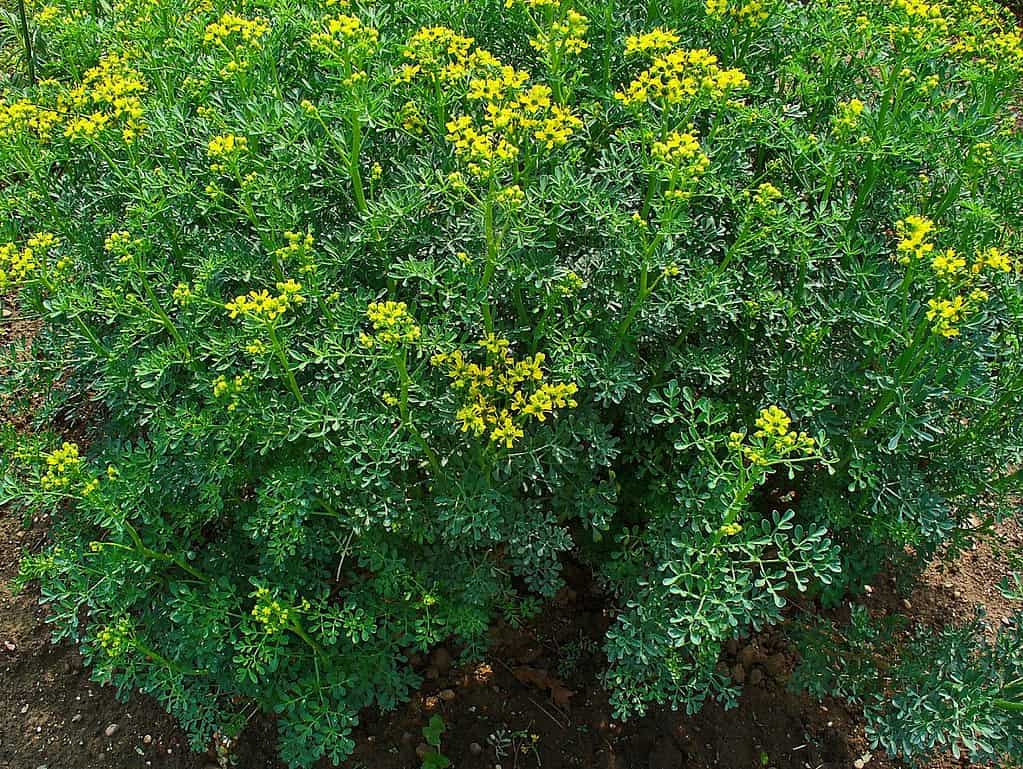
Rue’s smell repels the onion maggot so that they will not lay eggs on garlic.
©H. Zell / CC BY-SA 3.0, via Wikimedia Commons – Original / License
In addition to its culinary uses, garlic has long been valued for its natural repellent properties in the garden. One of the most effective companion plants to enhance the growth and protection of garlic is rue, otherwise called rue plant (Ruta graveolen). Rue has a strong, pungent aroma. It acts as a powerful deterrent against onion flies that pose a threat to garlic bulbs.
When planted near garlic, rue emits a distinct scent. The smell repels the onion maggot so that they will not lay eggs on the garlic. This further reduces their likelihood of attacking and damaging the precious bulbs. This natural defense mechanism helps safeguard the health and productivity of your garlic crop, ensuring robust growth and bountiful harvests.
The symbiotic relationship between garlic and rue extends beyond mere pest control. Both plants thrive when grown together due to their complementary characteristics. Garlic enriches the soil by deterring harmful insects with its own sulfur compounds. Rue further reinforces this protective shield through its potent fragrance.
13. Roses
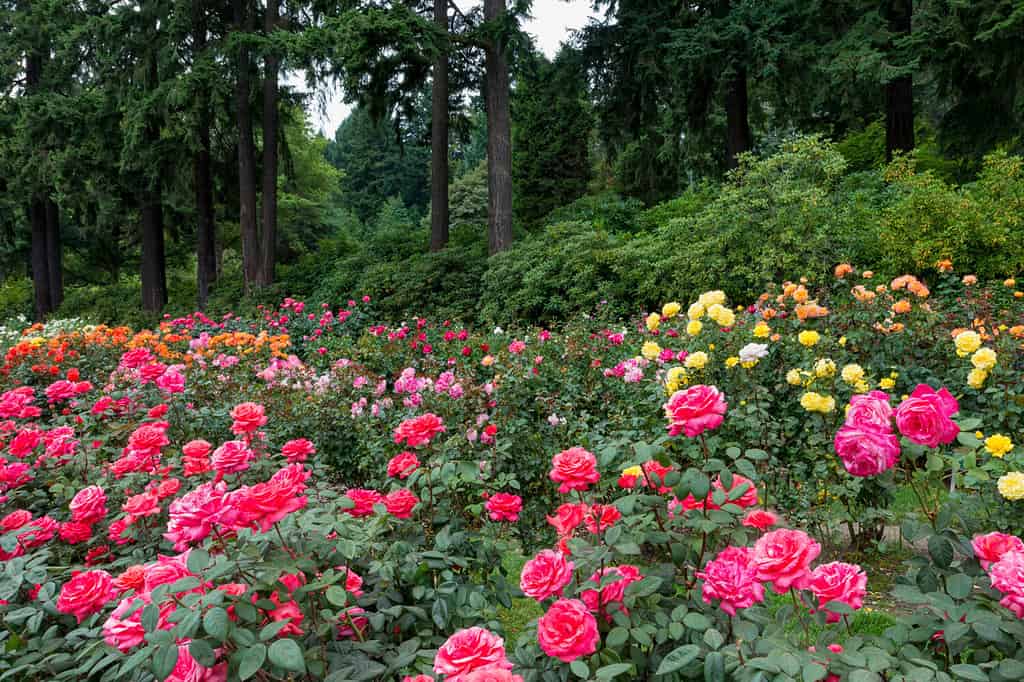
Every kind of rose you can grow benefits greatly from garlic nearby, which can ward off aphids.
©Nagel Photography/Shutterstock.com
Garlic, a versatile and powerful plant, has long been recognized for its numerous benefits when paired with roses. One of the most notable advantages is its ability to ward off aphids. These tiny insects are notorious for inflicting damage on rose plants. By planting garlic near roses, gardeners can effectively create a natural barrier. This deters these pesky pests from wreaking havoc on their precious blooms.
In addition to repelling aphids, garlic also plays a crucial role in combating fungal diseases. Many diseases plague roses, such as the feared black spot fungus. This common affliction can cause unsightly black spots on leaves and severely weaken the overall health of rose plants. By incorporating garlic into the vicinity of roses, gardeners can harness its antifungal properties. This will minimize the occurrence and severity of such diseases.
Beyond its pest-repellent qualities, it is believed that garlic may enhance the fragrance emitted by roses. This is a delightful bonus for any avid gardener or enthusiast. As this intriguing theory suggests an interaction between compounds present in both garlic and roses’ aromatic molecules when grown together.
Incompatible Plants for Garlic
When it comes to planting a successful garden bed, choosing the right companions for your plants is crucial. Some plants just don’t get along well together and can negatively affect each other’s growth or attract pests. Understanding these incompatibilities helps ensure healthier crops, improved yields, and overall gardening success.
Beans and Peas
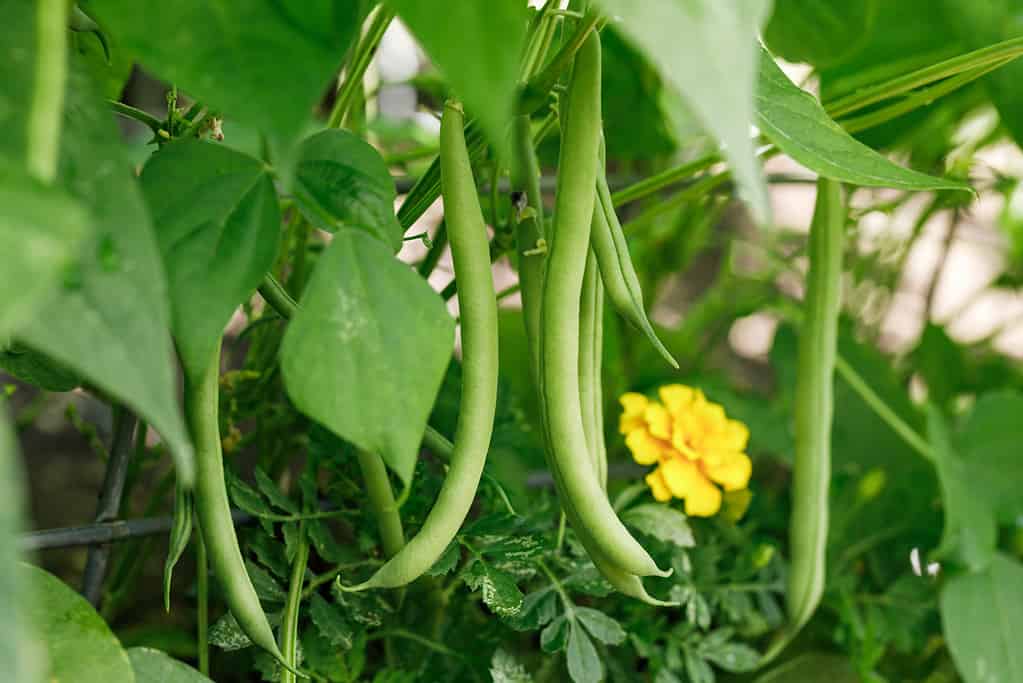
Planting beans near garlic hinders nitrogen fixation, leading to suboptimal bean growth.
©iStock.com/eurobanks
When it comes to selecting companion plants for beans, one must exercise caution and steer clear of the allium family. This includes onions, garlic, leeks, and scallions. While these herbs may be beloved in their own right, they can have inhibitory effects on bean growth.
The reason behind this lies in a substance released by the allium family. The substance disturbs the delicate balance of beneficial bacteria residing on bean roots. By disrupting this symbiotic relationship, nitrogen fixation is hindered, leading to suboptimal bean growth. Therefore, it is advisable to explore alternative companions that do not belong to the allium family when seeking out ideal partners for your beans.
Asparagus
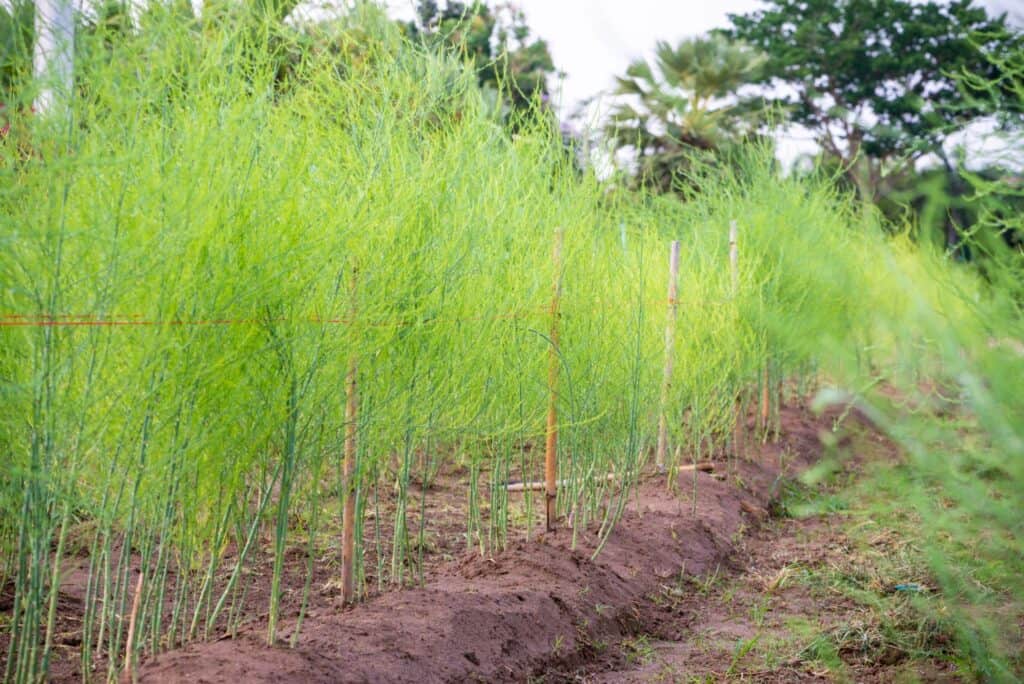
Garlic’s extensive root systems can interfere with the delicate and slow-growing roots of asparagus.
©Yongkiet Jitwattanatam/Shutterstock.com
When it comes to planting asparagus, it is crucial to consider its companions carefully. Alliums like garlic and onion may seem like suitable choices. But, they can actually hinder the growth of asparagus due to their nutrient requirements and slow-growing nature.
Alliums have a voracious appetite for nutrients, which can deplete the soil surrounding them. Additionally, their extensive root systems have the potential to interfere with the delicate and slow-growing roots of asparagus plants. This interference can result in stunted stalks or even prevent any stalks from developing at all. Therefore, it is essential to avoid planting garlic or onion near asparagus if you want your crop to thrive abundantly.
Sage
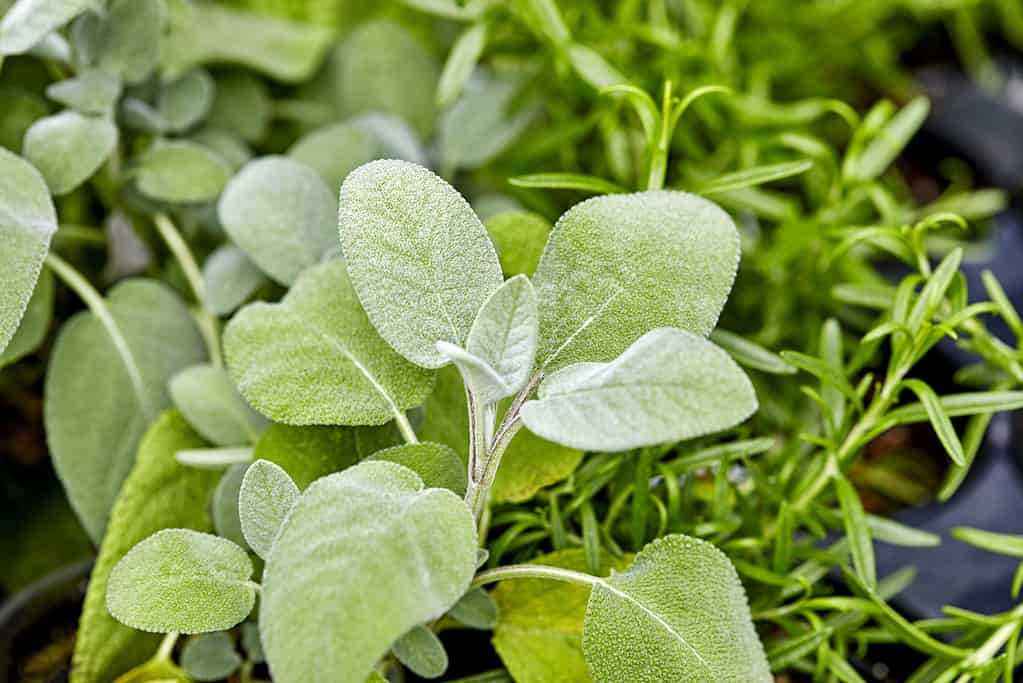
When competing for nutrients in the soil, both garlic and sage may experience stunted growth.
©iStock.com/wingedwolf
When it comes to cultivating a thriving garden, it is essential to consider the unique nutritional requirements of each plant. Garlic and sage are both fantastic additions to any herb garden or kitchen. They have distinct nutritional needs that should be taken into account when planning their placement. These two plants can certainly coexist harmoniously in the same garden bed. Planting them too closely together may lead to unfavorable consequences.
When competing for nutrients in the soil, both garlic and sage may experience stunted growth. Moreover, an overcrowded environment can result in a reduction of flavor and aroma, specifically in the sage leaves. Therefore, ensuring adequate spacing between these herbs will contribute to their optimal development and enhance your overall gardening experience.
Parsley
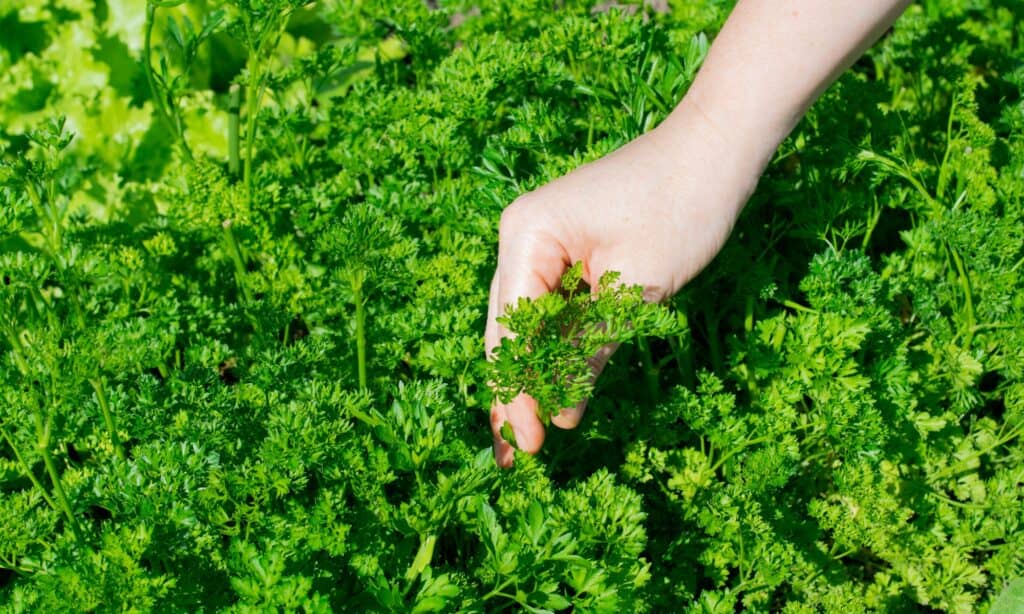
Parsley has both curly and flat-leaf varieties. Neither of them grows well near garlic plants.
©iStock.com/Oksana Chaun
Garlic and parsley are two beloved culinary herbs. But, they may not make the best companions in your garden due to their contrasting soil and light preferences. While garlic thrives in well-drained soil with ample sunlight exposure, parsley prefers a slightly moister environment and partial shade. This divergence in requirements creates a potential challenge as these plants vie for limited resources and nutrients within the soil.
Another factor to consider is the disparity in their life cycles. Parsley is a biennial plant that requires two seasons to complete its life cycle. Whereas garlic completes its growth cycle within one season as an annual plant. These divergent characteristics should be taken into account when deciding on suitable companion plants for garlic.
Strawberries
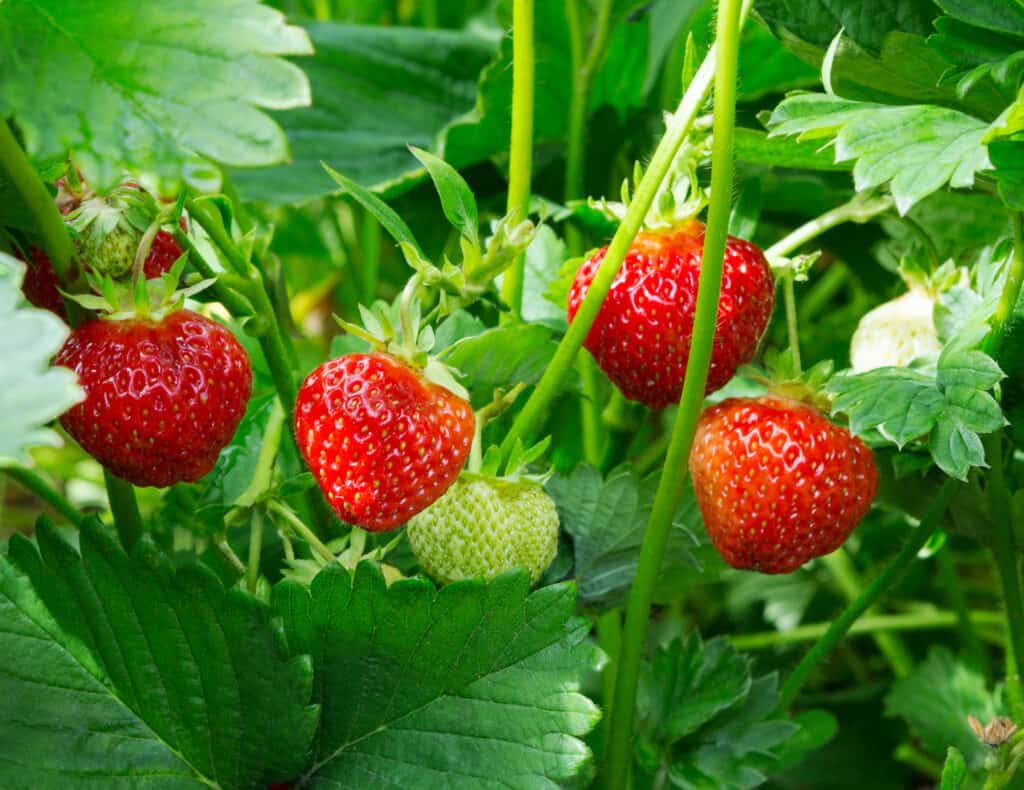
Unless you like garlic-flavored strawberries, don’t plant strawberries near a garlic plant.
©iStock.com/romiri
When it comes to gardening, careful consideration must be given to the companionship between plants. While garlic and strawberries may seem like an unlikely duo, it is important to keep them separate in your garden. There are several reasons for this cautious decision.
Firstly, both garlic and strawberries can fall prey to similar pests and diseases, making them vulnerable when planted together. Moreover, the growth of strawberries can suffer due to garlic’s ability to obstruct sunlight. Garlic also engages in fierce competition for essential nutrients within the soil. Lastly, one cannot overlook the powerful aroma emitted by garlic. This can potentially taint the delicate flavor profile of succulent strawberries, leading to garlic-flavored strawberries.
Summary of 13 Best Garlic Companion Plants
Here’s a recap of the plants we took a look at that can be suitable for planting near garlic.
| Number | Plant |
|---|---|
| 1 | Beets |
| 2 | Cucumbers |
| 3 | Fruit Trees |
| 4 | Eggplants |
| 5 | Tomatoes |
| 6 | Peppers |
| 7 | Spinach |
| 8 | Brassicas |
| 9 | Potatoes |
| 10 | Tarragon |
| 11 | Dill |
| 12 | Rue |
| 13 | Roses |
The photo featured at the top of this post is © Liubomyr Tryhubyshyn/Shutterstock.com
Thank you for reading! Have some feedback for us? Contact the AZ Animals editorial team.







